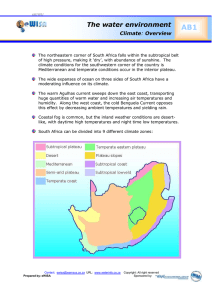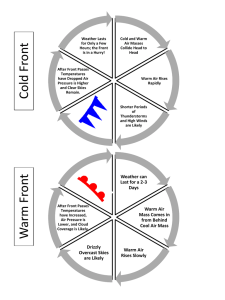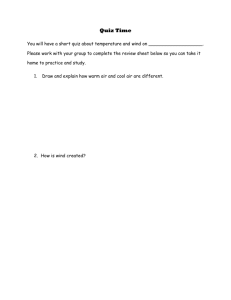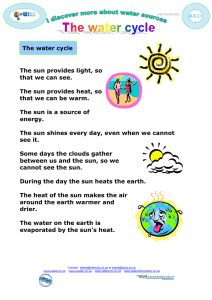1000 Years of Climate Change
advertisement
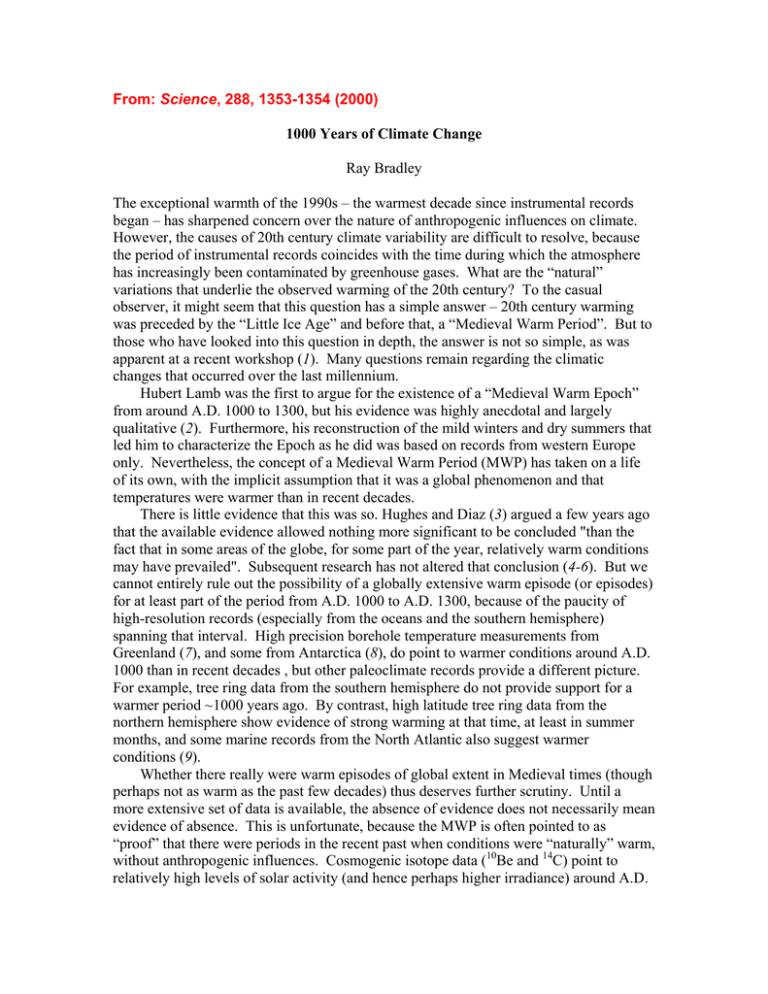
From: Science, 288, 1353-1354 (2000) 1000 Years of Climate Change Ray Bradley The exceptional warmth of the 1990s – the warmest decade since instrumental records began – has sharpened concern over the nature of anthropogenic influences on climate. However, the causes of 20th century climate variability are difficult to resolve, because the period of instrumental records coincides with the time during which the atmosphere has increasingly been contaminated by greenhouse gases. What are the “natural” variations that underlie the observed warming of the 20th century? To the casual observer, it might seem that this question has a simple answer – 20th century warming was preceded by the “Little Ice Age” and before that, a “Medieval Warm Period”. But to those who have looked into this question in depth, the answer is not so simple, as was apparent at a recent workshop (1). Many questions remain regarding the climatic changes that occurred over the last millennium. Hubert Lamb was the first to argue for the existence of a “Medieval Warm Epoch” from around A.D. 1000 to 1300, but his evidence was highly anecdotal and largely qualitative (2). Furthermore, his reconstruction of the mild winters and dry summers that led him to characterize the Epoch as he did was based on records from western Europe only. Nevertheless, the concept of a Medieval Warm Period (MWP) has taken on a life of its own, with the implicit assumption that it was a global phenomenon and that temperatures were warmer than in recent decades. There is little evidence that this was so. Hughes and Diaz (3) argued a few years ago that the available evidence allowed nothing more significant to be concluded "than the fact that in some areas of the globe, for some part of the year, relatively warm conditions may have prevailed". Subsequent research has not altered that conclusion (4-6). But we cannot entirely rule out the possibility of a globally extensive warm episode (or episodes) for at least part of the period from A.D. 1000 to A.D. 1300, because of the paucity of high-resolution records (especially from the oceans and the southern hemisphere) spanning that interval. High precision borehole temperature measurements from Greenland (7), and some from Antarctica (8), do point to warmer conditions around A.D. 1000 than in recent decades , but other paleoclimate records provide a different picture. For example, tree ring data from the southern hemisphere do not provide support for a warmer period ~1000 years ago. By contrast, high latitude tree ring data from the northern hemisphere show evidence of strong warming at that time, at least in summer months, and some marine records from the North Atlantic also suggest warmer conditions (9). Whether there really were warm episodes of global extent in Medieval times (though perhaps not as warm as the past few decades) thus deserves further scrutiny. Until a more extensive set of data is available, the absence of evidence does not necessarily mean evidence of absence. This is unfortunate, because the MWP is often pointed to as “proof” that there were periods in the recent past when conditions were “naturally” warm, without anthropogenic influences. Cosmogenic isotope data (10Be and 14C) point to relatively high levels of solar activity (and hence perhaps higher irradiance) around A.D. 1000; orbital considerations also suggest that, at least in boreal summers, insolation was slightly higher at that time (10, 11). Solar activity levels were generally lower than in Medieval times for most of the last millennium, only reaching comparable levels in the latter half of the 20th century, and this issue is therefore very important for understanding our current climate state. Do we have any better ideas about climatic conditions after the purported Medieval Warm Period? As we move forward in time, the amount of information increases rapidly, and the temporal and geographical patterns of climate change come increasingly into focus as the 20th century is approached. By the mid-16th century, global temperatures were colder than in previous centuries, and alpine glaciers around the world – a sensitive bellwether of temperature change – generally advanced. This period of glacier advance, called the Little Ice age (LIA), lasted until the mid to late 19th century in most regions. But even within this period there were warmer episodes; for example, the 18th century was warmer than the preceding and subsequent centuries, and in some periods winters were often markedly cool while summers remained relatively warm. The geographical patterns also varied; some areas were warm when others were quite cold (12). Furthermore, there is evidence that the first post-medieval advance of glaciers occurred as early as the 13th century in some areas, and the 14th and 15th centuries in others (13). But whatever date one selects for the “onset” of the LIA, there is little doubt that it was firmly at an end by the beginning of the 20th century. The reduction in ice masses accumulated over preceding centuries has continued to the present (in fact, the rate has accelerated) in almost all regions of the world (14) (see the figure). How can these changes be quantified, and what can we learn about their causes? Several reconstructions of large-scale temperature changes have been made using various sets of paleoclimate data, from tree rings and ice cores to corals, sediments, and historical records (4, 6, 15). These reconstructions point to a general decline in temperature from ~A.D. 1000 (or earlier) to ~A.D. 1900, with rapid warming over the last century that has no counterpart in the millennial record. Independent reconstructions derived from borehole temperatures suggest even colder temperatures about 400 to 500 years ago, and/or even greater warming in the 20th century. To what extent these differences in reconstructed temperatures are related to the effect of land use change on borehole temperatures remains to be resolved, but it suggests that land use change may be another factor, in addition to changes in atmospheric trace gases and aerosols, that may have to be taken into account to realistically simulate past (and future) climate change. There are indications that the long-term variability of the oceans may also have played a key role in climate variations of the last millennium. Broecker et al. hypothesize that there may have been a reduction in North Atlantic deepwater formation (and a concomitant reduction in the Gulf Stream/North Atlantic Drift) during the LIA, with opposite conditions during the MWP (16). This may have been the result of an oscillation between deepwater production in the North Atlantic and the Southern Ocean, implying a period of reduced Southern Ocean deepwater formation (with associated colder conditions in that region) during the MWP and enhanced production (warmer conditions) in the LIA. There are very few records from the Southern Ocean to test this idea, but there is intriguing evidence for more open water, at least in the Ross Sea, during the LIA (17). Borehole temperatures from Taylor Dome (but not from other Antarctic ice core sites) also point to warmer conditions in the LIA (8), and lower temperatures in Medieval times. How all this fits with mounting evidence for a periodic increase every 1400 to 1500 years in ice-rafted debris across the North Atlantic remains to be resolved. The LIA may have just been one of many oscillations within the Holocene, driven either by internal ocean system dynamics, or quasi-regular external forces not yet resolved. Many questions remain about the nature and causes of climate changes over the last millennium, and it is easy to overlook what we do know that is relevant to the present debate over global warming. One fact stands out as indisputable: temperatures rose in the 20th century at a rate unprecedented in the last millennium. Future research is unlikely to shake that conclusion. It is also very probable that temperatures at the end of the 20th century were higher than at any time in the last millennium; the latter half of the century was probably one of the warmest fifty-year periods for several millennia (11). However, more research is needed to consolidate and verify that conclusion. Much remains to be learnt about the climate forcing mechanisms that operated over the last millennium, but current research clearly implicates anthropogenic greenhouse gases in the remarkable temperature changes of the last century (15). Given that the atmospheric CO2 concentration is now higher than at any time in (at least) the last 420,000 years (18), that it will almost certainly double within the next century, and that a considerable amount of heat has already been sequestered in the upper ocean during this century (19), the climatic and environmental changes of the last millennium may be trivial compared to those in the near future. References and Notes 1. Mini-Conference on the Little Ice Age and Medieval Warm Period, Lamont Earth Observatory, Palisades, New York, March 30-31, 2000 (convened by W.S. Broecker. 2. H. H. Lamb, Palaeogeogr. Palaeoclimatol. Palaeoecol. 1, 13 (1965); H. H. Lamb, UNESCO Arid Zone Research 20, 125 (1963). 3. M. K. Hughes and H. F. Diaz, Clim. Change 26, 109 (1996). 4. M. E. Mann, R. S. Bradley, M. K. Hughes, Geophys. Res. Lett. 26, 759 (1999). 5. T. J. Crowley and T. S. Lowery, Ambio 29, 51 (2000). 6. P. D. Jones et al., The Holocene 8, 455 (1998). 7. H. N. Pollack et al., Science 282, 279 (1998); S-P. Huang et al., Nature 403, 756 (2000); D. Dahl-Jensen et al., Science 282, 268 (1998). 8. G. D. Clow and E. D. Waddington, Abstract, IUGG (Birmingham, 1999). 9. L. D. Keigwin, Science 274, 1504 (1996); L. D. Keigwin and R. S. Pickert, Science 286, 520 (1999). 10. J. Beer et al., in Climatic Variations and Forcing Mechanisms of the Last 2000 Years, P. D. Jones, R. S. Bradley, J. Jouzel, Eds. (Springer, Berlin, 1994), 501-517; L. R. McHargue and P. E. Damon, Rev. Geophys. 29, 141 (1991); E. Bard et al., Tellus, B52:3 (in press) (2000). 11. R. S. Bradley, Quat. Sci. Rev. 19 391 (2000). 12. P. D. Jones and R. S. Bradley, in Climate Since A.D. 1500, R. S. Bradley and P. D. Jones, Eds. (Routledge, London, 1992), 649-665. 13. J. M. Grove and R. Switsur, Clim. Change 26, 143 (1994); B. H. Luckman, in Climatic Variations and Forcing Mechanisms of the Last 2000 Years, P. D. Jones, R. S. Bradley, J. Jouzel, Eds. (Springer, Berlin, 1994), 85-108. 14. M.B. Dyurgerov and M.F. Meier, Proc. National Academy of Sciences, 97, 14061411 (2000). 15. J. T. Overpeck et al., Science 278, 1251 (1997); M. E. Mann, R. S. Bradley, M. K. Hughes, Nature 392, 779 (1998). 16. W. S. Broecker, S. Sutherland, T.-H. Peng, Science 286, 1132 (1999). 17. A. Leventer et al., Paleoceanography 8, 373 (1993). 18. J. Jouzel et al., Nature 399, 429 (1999); D. Raynaud et al., Quat. Sci. Rev. 19, 9 (2000). 19. S. Levitus et al., Science 287, 2225 (2000). 20. Supported by the National Science Foundation and the Department of Energy. I thank W. S. Broecker for inviting me to the Lamont meeting, and J. T. Overpeck, H. F. Diaz, M. Mann and M. K. Hughes for comments. Figure 1. 20th century retreat. The Dana Glacier, Sierra Nevada, California (3660 m, 37° 54'N, 119° 13'W) in 1883 (above) and in 1985 (below) showing how the glacier has retreated since the late 19th century (credits: U.S.Geological Survey; Scott Stine).
